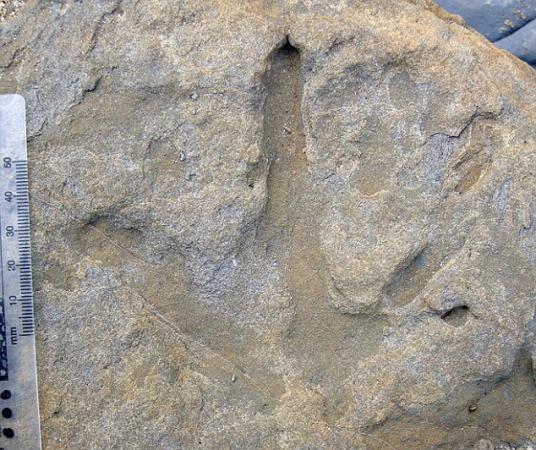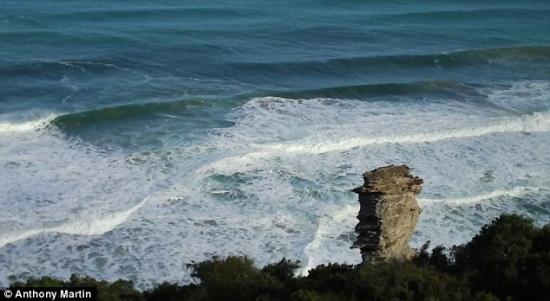摘要:据国外媒体报道,最近,在澳大利亚发现了20多个三趾恐龙的足迹,这是南半球目前发现的规模最大、保存最完好的极地恐龙足迹群。
古生物学家在8月9日在《Alcheringa》杂志上刊载了这一消息,这些足迹是在澳大利亚维多利亚的多岩石的海岸发现的,这些岩石已经距今1.05亿年。
这一类恐龙的盛行要追溯到1.15到1.05亿年前澳大利亚连接到极地大陆之时,当时这些庞大的生物花了近几个月的时间在无尽的黑暗之中漫游。古生物学家称,这一新发现的足迹群,可能是在夏季洪水冲击过的平原上形成,而洪水则是极地冰层融化后冲进河流、溪谷而成。发现恐龙足迹的砂岩也同样发现了水流的波纹和一些昆虫类洞穴的印记。
埃默里大学的古生物学家Anthony Martin说:“这些足迹给我们提供了一个准确的指标物:在重要的地质学历史时代中,这些恐龙是如何和极地生态系统相互作用、相互影响的。”
这些足迹来自不同体型的兽脚类恐龙,小到一只鸡的身形,大到一台起重机那么庞大。兽脚类恐龙是两足恐龙,现代鸟类的祖先,主要是食肉型恐龙。
生物探索推荐英文原文报道:
The wonderful lizards of Oz: Over 20 three-toed dinosaur tracks found on Australian coast
A group of more than 20 three-toed dinosaur tracks has been discovered on the coast of Victoria, Australia.
The find is the largest and best collection of polar dinosaur tracks ever found in the Southern Hemisphere.
It offers a rare glimpse into animal behaviour during the last period of pronounced global warming, about 105million years ago.

Sunken treasure: A group of more than 20 three-toed dinosaur tracks has been discovered on the coast of Victoria, Australia. The find is the largest and best collection of polar dinosaur tracks ever found in the Southern Hemisphere
Lead researcher Anthony Martin, from Emory University in Atlanta, Georgia, said: 'These tracks provide us with a direct indicator of how these dinosaurs were interacting with the polar ecosystems, during an important time in geological history.'
The three-toed tracks are preserved on two sandstone blocks from the Early Cretaceous Period.
They appear to belong to three different sizes of small theropods - a group of bipedal, mostly carnivorous dinosaurs whose descendants include modern birds - and were found on the rocky shoreline of remote Milanesia Beach, in Otways National Park.
This area, west of Melbourne, is known for energetic surf and rugged coastal cliffs, consisting of layers of sediment accumulated over millions of years.
Riddled with fractures and pounded by waves and wind, the cliffs occasionally shed large chunks of rock, such as those containing the dinosaur tracks.
One sandstone block has about 15 tracks, including three consecutive footprints made by the smallest of the theropods, estimated to be the size of a chicken.
Dr Martin spotted this first known dinosaur track-way of Victoria in June last year. He was on the lookout, since he had earlier noticed ripple marks and trace fossils of what looked like insect burrows in piles of fallen rock.
He said: 'The ripples and burrows indicate a floodplain, which is the most likely area to find polar dinosaur tracks.'

Lead researcher Anthony Martin sits in front of two tracks. The three-toed imprints are preserved on two sandstone blocks from the Early Cretaceous Period
The second block containing tracks was spotted about three hours later by Greg Denney, a local volunteer who accompanied Dr Martin and Thomas Rich, from the Museum of Victoria, on that day's expedition.
That block had similar characteristics to the first one, and included eight tracks. The tracks show what appear to be theropods ranging in size from a chicken to a large crane.
Dr Martin said: 'We believe that the two blocks were from the same rock layer, and the same surface, that the dinosaurs were walking on.'
The small, medium and large tracks may have been made by three different species, he said.
'They could also belong to two genders and a juvenile of one species – a little dinosaur family – but that's purely speculative.'
The Victoria Coast marks the seam where Australia was once joined to Antarctica.
During that era, about 115 to 105million years ago, the dinosaurs roamed in prolonged polar darkness.
The Earth's average temperature was 68F - just ten degrees warmer than today - and the spring thaws would cause torrential flooding in the river valleys.

The tracks were found on the rocky shoreline of remote Milanesia Beach, in Otways National Park. They appear to belong to three different sizes of small theropods - a group of bipedal, mostly carnivorous dinosaurs whose descendants include modern birds
The dinosaur tracks were probably made during the summer, Dr Martin said.
'The ground would have been frozen in the winter, and in order for the waters to subside so that animals could walk across the floodplain, it would have to be later in the season,' he explained.
Lower Cretaceous strata of Victoria have yielded the best-documented assemblage of polar dinosaur bones in the world. Few dinosaur tracks, however, have been found.
In February 2006, Dr Martin found the first known carnivorous dinosaur track in Victoria, at a coastal site known as Dinosaur Dreaming.
In May 2006, during a hike to another remote site near Milanesia Beach, he discovered the first trace fossil of a dinosaur burrow in Australia.
That find came on the heels of Martin's co-discovery of the first known dinosaur burrow and burrowing dinosaur, in Montana.
The two discoveries suggest that burrowing behaviours were shared by dinosaurs of different species, in different hemispheres, and spanned millions of years during the Cretaceous Period.
The research is published in the journal Alcheringa,







